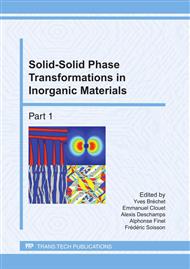p.833
p.839
p.845
p.851
p.857
p.863
p.869
p.875
p.881
Modelling Age Hardening CuCr1Zr Electrode Alloy Softening during Resistance Spot Welding
Abstract:
High strength zinc-coated steels are used for automotive applications when high corrosion resistance and weight reduction are required. Resistance spot welding is the main method to assembly auto body. Steel sheets are held together under pressure exerted by copper alloy electrodes which concentrate welding current and clamp the sheets together. But welding of high strength coated steels reduces the electrode life. Even if electrode deterioration is a well-known problem, the understanding and modelling of the complex deterioration modes at different regions of the electrode is still limited. Developing a comprehensive thermo-electrical-metallurgical-mechanical model that describes the sequential deterioration is thus lacking. This work is a preliminary study which specifically addresses microstructural evolution modelling in age hardened CuCr1Zr electrode alloy. Evolution of precipitation is simulated using two models: a Johnson-Mehl-Avrami-Kologoromov model and the Myhr and Grong model. In both cases a calibration procedure based on hardness data was involved. Short isothermal heat treatments were used to develop a ‘master curve’ which captures the precipitate evolution. Preliminary results about the comparison of the two models are presented.
Info:
Periodical:
Pages:
857-862
Citation:
Online since:
June 2011
Price:
Сopyright:
© 2011 Trans Tech Publications Ltd. All Rights Reserved
Share:
Citation:


